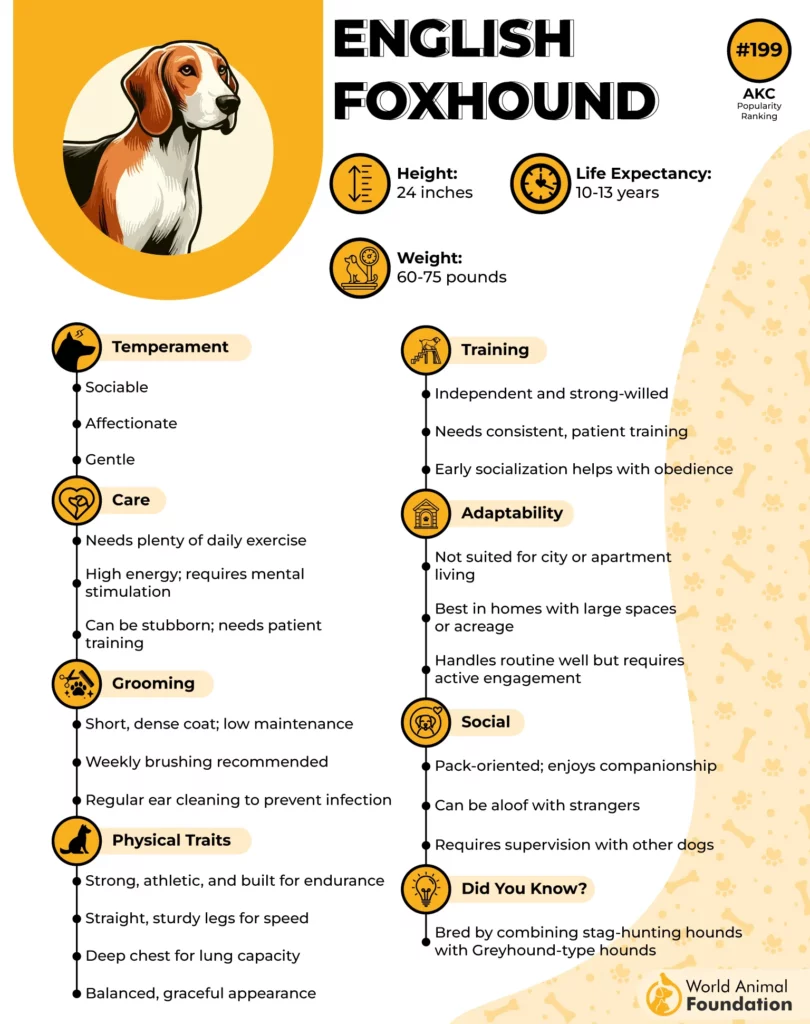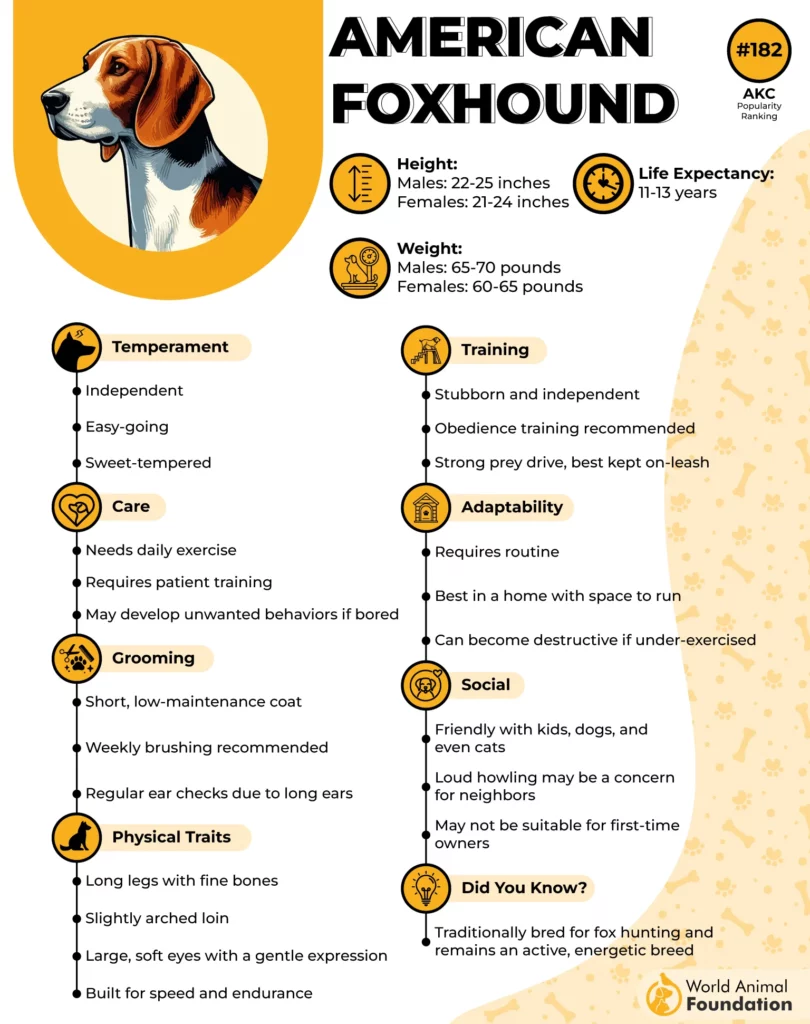Let’s be real—when you hear “foxhound,” your mind probably goes straight to wild hunts, loud bays, and the kind of energy only dogs bred to hunt possess. But did you know the American Foxhound and the English Foxhound are actually quite different breeds, despite their similar names?
Whether you’re a seasoned hunter, a pet enthusiast, or just trying to figure out which of these dog breeds would fit into your life, this guide’s got you. So, grab your coffee (or your dog’s leash), and let’s dive nose-first into the foxhound world.
American Foxhound vs. English Foxhound
American Foxhound vs. English Foxhound: Origins and History
Let’s rewind time a little. The English Foxhound has deep roots in—you guessed it—England. Bred during the 16th century, these hunting dogs were developed specifically for hunting foxes alongside horses, with rich aristocrats cheering them on. Think royal sport meets canine excellence.

Fast forward to the 1700s. George Washington, one of the earliest American breeders, wanted a new kind of foxhound. He mixed English Foxhounds with French hounds, Irish foxhounds, and even French foxhounds to create the leaner, speedier American Foxhound.
Despite being closely related, these two breeds evolved with different needs in mind. The English Foxhound remained sturdy and pack-oriented, ideal for group hunts in controlled settings. Meanwhile, the American breed developed into a sleeker, more independent hound, built for covering miles on the trail of elusive prey.
And here’s a cool tidbit—George Washington even kept his own kennels of these trailblazing dogs, making him one of the original American hound enthusiasts.
American Foxhound vs. English Foxhound: Physical Characteristics
Now, let’s talk looks. Picture this: the English Foxhound is the strong, broad-shouldered older brother who played football in high school, while the American Foxhound is the lean, long-legged sibling who runs marathons and barely breaks a sweat. Both come from the same family, but their builds give off totally different vibes.
American Foxhounds have longer legs, we can say straight legs, and an overall more slender frame. They typically come in a few colors, most often black, white, and tan. As per Purina, their coat is short and hard to the touch—ideal for dashing through thick underbrush. Oh, and those signature floppy ears? Yup, both breeds have them!

Meanwhile, the English Foxhound is stockier, with a deeper chest and slightly heavier bones. They’ve got strong shoulders and an ideal size and weight (as per PetMD, 60-75 pounds), for keeping up with horses on hunts. Their coat is also short and dense, built to handle the rough world of hunting.
Despite their physical differences, both breeds still carry that classic foxhound look—noble eyes, long tails, strong noses, and of course, that legendary bay. They might look different in motion, but when they’re staring down a squirrel like it’s the most serious threat to mankind, you’ll be reminded they share the same determined spirit.
American Foxhound vs. English Foxhound: Trainability and Intelligence Comparison
Here’s where it gets fun (and maybe a little challenging). These dogs are smart, but they’re also scent hounds through and through. Which means? Their smell comes before your commands.

The American Foxhound, being an American breed, tends to be a bit more independent. This dog will follow its nose for miles, especially when it’s tracking small game or prey. Training them takes patience and consistency. Got a treat? Great. Got bacon? Even better.
The English Foxhound, on the other hand, is a bit more people-oriented, which makes training slightly easier. But don’t expect instant obedience—these dogs were bred for pack work, not tricks and games. They respond best to activities that tap into their instincts, like scent trails, obstacle courses, and even long walks with sniffing time built in.
They’re intelligent, no doubt. But also, let’s be honest, a little stubborn. You’re not just training a dog; you’re negotiating with a professional hunter.
American Foxhound vs. English Foxhound: Health and Common Conditions
When it comes to overall health, both the American Foxhound and English Foxhound are generally hardy, strong breeds. But hey, even the toughest dogs can have their off days—and these hounds do come with a few health red flags you’ll want to keep an eye on.
One of the biggest concerns for both breeds is hip dysplasia—a common issue in medium to large dogs. It’s a condition where the hip joint doesn’t sit properly in the socket, leading to discomfort, arthritis, and sometimes mobility problems later in life.
The best way to manage this? Regular vet checkups, daily moderate exercise, and making sure your hound stays at a healthy weight. Trust us—an overweight foxhound isn’t just unhealthy, it’s unhappy too.

Their deep chests, while great for endurance, can also increase the risk of bloat, a serious and sometimes life-threatening condition. Bloat usually happens when dogs eat too fast or gulp down lots of air. To prevent it, try using a slow feeder bowl and breaking up meals into smaller portions. It might seem like a small change, but it could save your pup’s life—and your vet bills.
American Foxhound vs. English Foxhound: Average Lifespan
Thinking long term? Great mindset! Choosing a dog is a big commitment, and you definitely want your furry friend around for years of wagging tails, belly rubs, and, let’s be honest, random barking at squirrels or shadows.
American Foxhounds usually enjoy a lifespan of 11 to 13 years, which is pretty solid for a larger breed. Their longevity largely depends on a few key factors—nutrition, exercise, genetics, and regular vet visits.

These hounds were bred to hunt and run for hours, so giving them enough space and opportunities to burn off energy is essential. With the right care and a healthy lifestyle, your American Foxhound will stay active and spirited well into their senior years.
On the other hand, as per Hillspet, English Foxhounds live around 10 to 12 years. Similar numbers, but their lifespan can be more affected by how they’re raised. Because they’re often kept in kennels or working environments with hunters, their daily routine plays a bigger role than genetics alone.

English Foxhounds raised in family homes with consistent care tend to live longer, healthier lives. A balanced diet, regular exercise, and plenty of affection go a long way in keeping them happy and healthy.
Conclusion
So, what’s the final verdict in the American Foxhound vs English Foxhound showdown?
If you’re after a sleek, fast, and independent hunter with roots tracing back to George Washington, the American Foxhound is your ideal match. Prefer a solid, traditional pack hound with a gentle nature and British charm? Then the English Foxhound is the one for you.
Both breeds are loyal, energetic, and bred to follow scent with passion. They’re not lazy lapdogs—they thrive with space, adventure, and owners who understand their deep hunting instincts. Compared to many other dogs, foxhounds demand more activity and purpose in their daily lives.
Whether you’re a seasoned hunter, an active family, or simply a dog lover who appreciates other breeds with rich histories, either foxhounds could be your perfect companion.
So, which one would you choose—American or English? Let us know in the comments below! We’d love to hear your thoughts.


